Trigonometry
Trigonometry ratios, sine, cosine and tangent can be used to calculate lengths of sides and sizes of angles in right-angled triangles.
Labelling the triangle
To understand and apply the ratios it is necessary to learn to label the triangle
The labels given to the other two sides, opposite and adjacent, are dependent on the angle being used in the question.
The angle θ is marked. The side opposite this angle is labelled opposite and the side beside the angle θ is labelled adjacent.
In this example the angle X is marked. The side opposite this angle is labelled opposite and the side beside the angle X is labelled adjacent.
Trigonometric ratios
The three trig ratios are:
\(Sine\ \theta = \frac{\textbf{O}pposite}{\textbf{H}ypotenuse}\)
\(Cosine\ \theta = \frac{\textbf{A}djacent}{\textbf{H}ypotenuse}\)
\(Tangent\ \theta = \frac{\textbf{O}pposite}{\textbf{A}djacent}\)
\(\sin \theta = \frac{O}{H}\)
\(\cos \theta = \frac{A}{H}\)
\(\tan \theta = \frac{O}{A}\)
One way to remember this is to use SOH CAH TOA
\(S_h^o\) \(C_h^a\) \(T_a^o\)
Finding the length of a side in a right-angled triangle
To find the length of a side when an angle and the length of one side are known:
- Label the sides of the triangle,
- Select the appropriate trig ratio by identifying which sides will be used,
- Use the trig ratio to calculate the missing side length.

Example
Find the length of the side QR on this right-angled triangle.

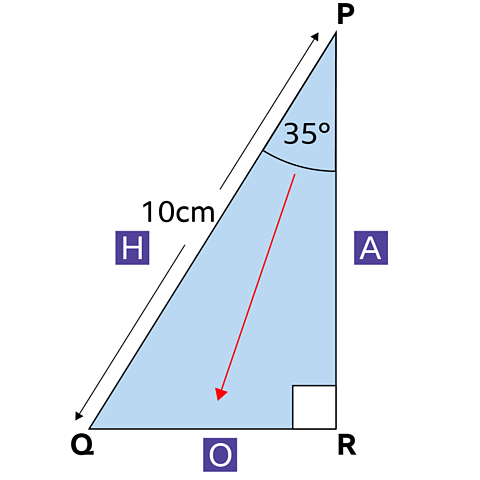
• Label the sides of the triangle
- PQ is the hypotenuse
- QR is opposite the 35° angle
- PR is adjacent/beside the 35° angle

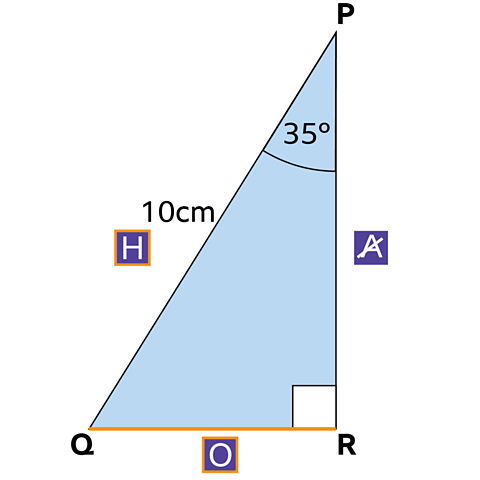
• Select the appropriate trig ratio by identifying which sides will be used
The hypotenuse, H is known and the opposite, O is needed.
The trig ratio which uses opposite and hypotenuse is Sine.
\(\sin \theta = \frac {O}{H}\)

• Use the trig ratio to calculate the missing side length.
\( \sin \theta = \frac{O}{H}\)
\( \sin 35 = \frac{QR}{10}\) - multiply both sides by 10
\( 10 \sin 35 = QR\) - use the calculator to find the value of QR
QR=5.74 cm (to 2 decimal places)
Question
Find the length of the side marked x.
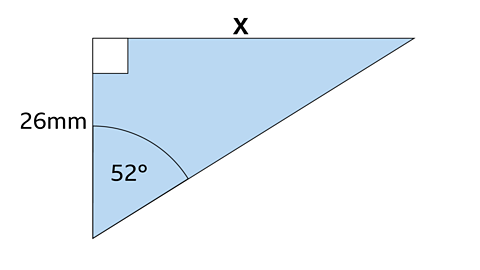

The trig ratio using O and A is \(\tan \theta = \frac{O}{A}\)
- \(\tan \theta = \frac{O}{A}\)
- \(\tan 52 = \frac{X}{26}\)
- \(X = 26 \tan 52 = 33.28\)
Answer
X = 33.28 mm (to 2 decimal places)
Example
Find the length of the hypotenuse on this right-angled triangle.
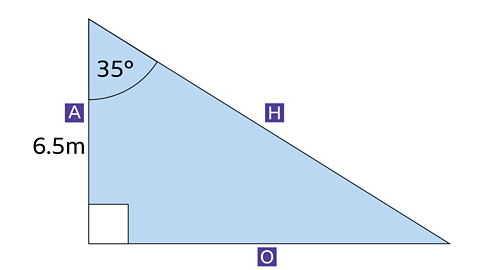
The trig ratio using A and H is \(\cos \theta = \frac{A}{H}\)
- \(\cos \theta = \frac{A}{H}\)
- \(\cos 35 = \frac{6.5}{H}\) - multiply both sides by H
- \(H \cos 35 = 6.5\) - divide both sides by cos 35
- \(H = 6.5 \div \cos 35\)
= 7.94 m (to 2 decimal places)
Question
Find the height of the rectangle.

Solution:
Identify the right-angled triangle and label the sides
The trig ratio using O and A is \(\tan \theta = \frac{O}{A}\)
- \(\tan \theta = \frac{O}{A}\)
- \(\tan 58 = \frac{2.8}{X}\)
- \(X \tan 58 = 4.8\)
- \(X = \frac {4.8}{\tan 58} = 2.99937…\)
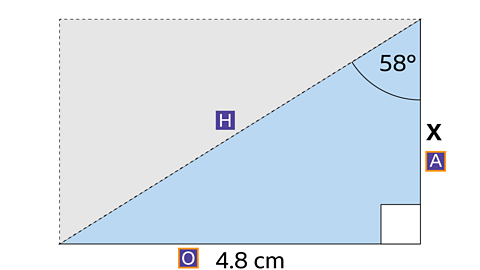
Answer:
X = 3.0 cm (to 1 decimal place)
Finding the size of an angle in a right-angled triangle
To find the size of an angle when the lengths of 2 sides are known:
- Label the sides of the triangle,
- Select the appropriate trig ratio by identifying which sides will be used,
- Use the inverse of the trig ratio to calculate the size of the angle.
Example
Calculate the size of the angle θ
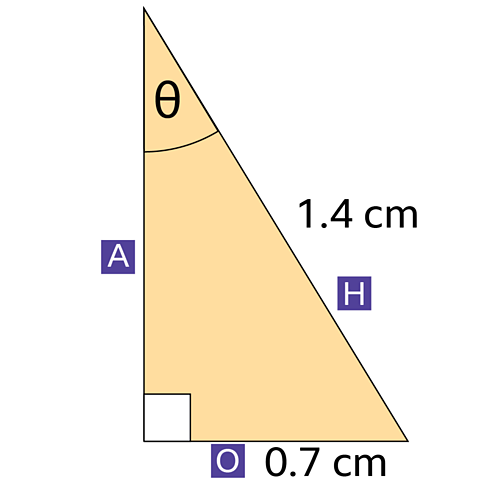
Label the sides of the triangle,
Select the appropriate trig ratio by identifying which sides will be used.
The opposite side and the hypotenuse are known, so use \(\sin \theta = \frac {O}{H} - \sin \theta = \frac {0.7}{1.4}\)Use the inverse of the trig ratio to calculate the size of the angle.
\(\theta = \sin^{-1}(\frac {0.7}{1.4})\)
\(\theta = 30^{\circ}\)

Question
Calculate the size of the angle p in the isosceles triangle to the nearest degree.

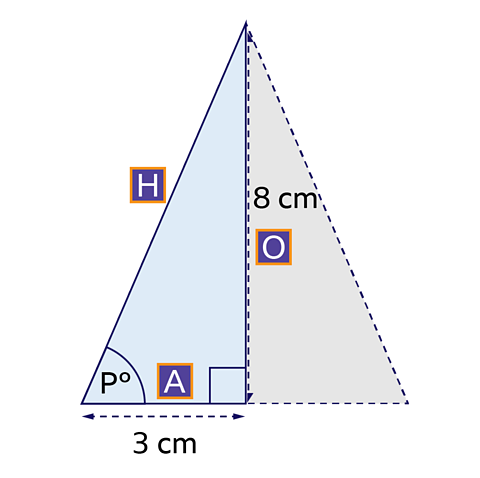
The trig ratio using A and O is \(\tan P =\frac{O}{A}\)
\(\tan p =\frac{O}{A}\)
\(\tan p =\frac{8}{3}\)
\(p =\tan^{-1}(\frac{8}{3})\)
p = 69.443…
Answer:
p = 69° (to the nearest degree)
Angles of elevation and depression
If a person stands and looks up at an object, the angle of elevation is the angle between the horizontal line of sight and the object.
If a person stands and looks down at an object, the angle of depression is the angle between the horizontal line of sight and the object.
Trigonometry can be used to solve problems involving angles of elevation and depression.
Example
An architect wants to calculate the height of a building. He places a clinometer 50 m away from the base of the building and measures the angle of elevation as 70°.
Calculate the height of the building to 2 decimal places.
The trig ratio using O and A is \(\tan \theta =\frac{O}{A}\)
\(\tan \theta =\frac{O}{A}\)
\(\tan 70=\frac{b}{50}\)
\(50\tan70= b\)
b = 137.37 m
Question
From the top of a 72 m high vertical cliff, a boat has an angle of depression of 32°.
How far is the boat from the base of the cliff? Give the answer correct to the nearest metre.
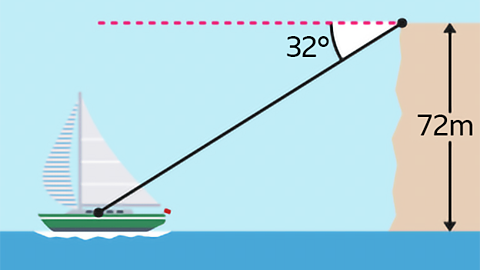
Image caption, How far is the boat from the base of the cliff? Give the answer correct to the nearest metre.
Image caption, Identify the right-angled triangle
Image caption, Identify the right-angled triangle
This angle will also be 32° because it is alternate to the angle of depression
Image caption, Label the sides of the triangle and select and apply the correct trig ratio
1 of 4
The trig ratio using O and A is \(\tan \theta = \frac{O}{A}\)
- \(\tan 32 = \frac{72}{A}\)
- \(A \tan 32 = 72\)
- \(A = \frac{72}{\tan 32} = 115.224…\)
Answer
A=115 m (correct to the nearest metre)
Test yourself
More on M3: Geometry and measures
Find out more by working through a topic